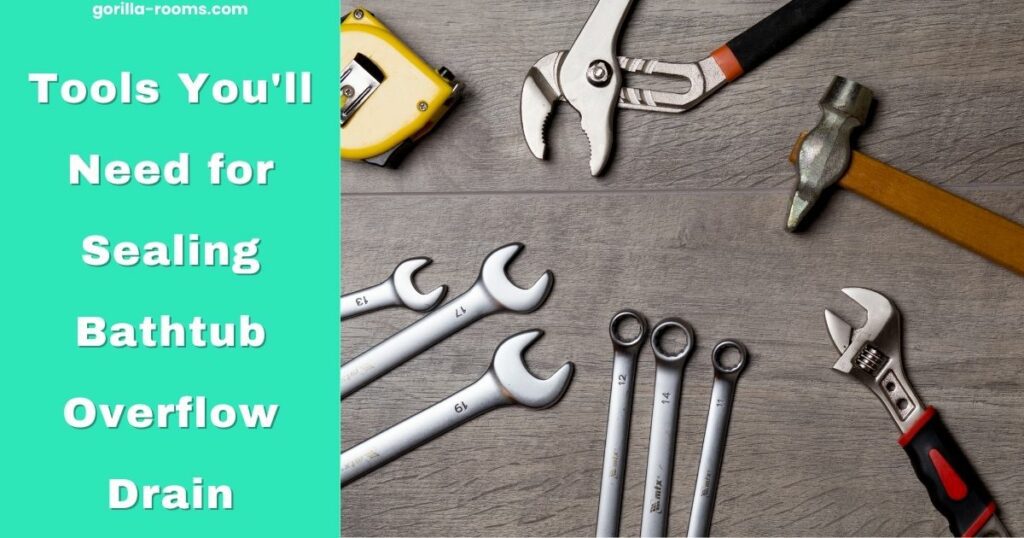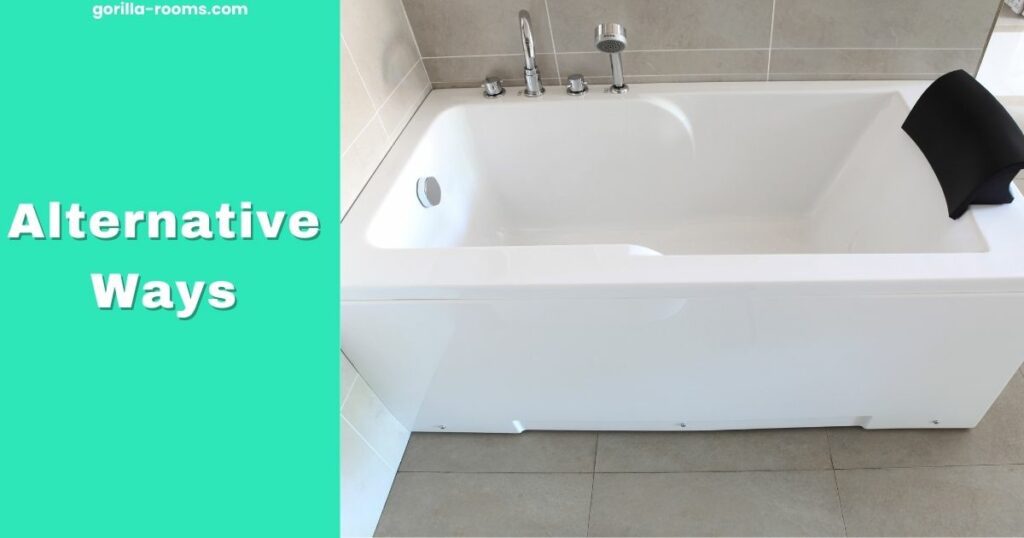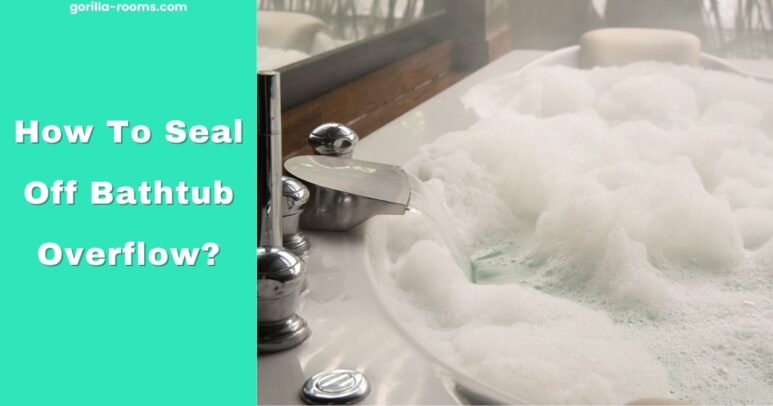Have you noticed signs of water leakage into your bathroom recently? Maybe you’ve noticed that water stains are starting to show up on the walls or ceiling. If that’s the case, you might have a leaky bathtub.
If you don’t fix it, it could result in water damage that could spread mold and mildew throughout your home. Look for signs that your bathtub is leaking and figure out where the problem is coming from as soon as possible to avoid expensive repairs.
If it turns out that your bathtub drain is the root cause, you’ll need to figure out if the leak is coming from the waste drain or the overflow drain. If you want to seal off your your tub overflow drain, there are many ways to do so.
For tips on how to seal off bathtub and overflow drains, I have included a list of solutions to help you. Continue reading for our simple and fast-fix advice on how to manage the overflow drain.
Can you seal off the bathtub overflow drain?
Yes, it is possible to seal off a bathtub overflow drain. Water may enter the overflow drain and cause damage to the flooring or ceiling below the bathtub, but sealing up overflow opening in the drain can help avoid this.
But it’s important to remember that the overflow drain is an important safety feature that keeps the bathtub from overflowing and flooding the bathroom.
So, if you block the overflow drain, watch the water level in the tub and don’t fill it up too high. Also, I suggest you remember that sealing off the overflow drain may not be allowed by plumbing codes in some areas.
So it’s always best to check with a certified plumber before modifying your bathtub’s drainage system.
Tools You’ll Need for Sealing Bathtub Overflow Drain

To seal a bathtub overflow drain, you will need the following tools:
- Silicone sealant: You will need the plumber’s putty or silicone sealant to create a watertight seal around the overflow drain.
- Putty knife: A putty knife or caulking gun will be required to apply the plumber’s putty or silicone sealant.
- Wrench or pliers: You may need a wrench or pliers to remove the overflow cover plate or any screws holding the cover plate in place.
- Rag or towel: A rag or towel will be required to remove any excess putty or sealant.
- Safety glasses: Safety glasses are advised when working on any plumbing-related project to protect your eyes from debris or splashes.
It’s essential to ensure that you have all the necessary tools before you begin the job to avoid delays or accidents.
How To seal off Bathtub Overflow Drain? Easy Steps To Follow
Once you have the basic materials, it’s time to start fixing your bathtub overflow drain leak.
1. Remove The Overflow Drain Plate
Remove any caulk surrounding the overflow drain plate using a utility knife or scraper.
Take off the overflow plate’s screws from the tub’s wall. If there are no visible screws, just lift the plate by resting your thumbs at the bottom and gently pushing up.
Be cautious while removing the screws from an older bathtub. You may need to replace the complete overflow plate assembly if they break.
Now that the new cover plate is off, you can see the drain pipe for the overflow. If a screw is holding a bracket above the drain hole, you should unscrew it.
2. Check The Overflow Pipe
Inspect the overflow pipe and ensure you can move it slightly inside the drain hole. If you do this, you may access the pipe’s rubber seal with a screwdriver and gently pry it off.
If the pipe is too hard and you cannot remove the gasket, All I would say is to call for a plumber. Most likely, a plumber will need to repair the gasket and a section of the overflow pipe.
3. Remove The Overflow Gasket
Just pull the rubber gasket to detach it from the pipe. To remove the drain pipe from the tub, you can use a screwdriver to move the pipe slightly. If it doesn’t come out by hand, try carefully prying it out with a screwdriver.
Take a close look at the gasket. If I find the cause of the leak in my bathtub’s overflow drain, I might think the gasket was dry-rotted or weakened.
Carefully check the overflow pipe and wipe away dirt or grime from the gasket.
4. Replace The Overflow Gasket
You may check the beveled edge of the new gasket by holding it on its side (i.e., if one side is thicker than the other). Reading this will give you a better idea of how to set it up.
Place the gasket in the overflow drain covers’ hole so that its center is exposed. If the gasket is beveled, the thinner side will fit around the overflow drain’s top, and the broader side will fit around the bottom.
You may use your fingers to push the gasket into place, sealing up the drain hole.
Before installing a new gasket, ensure it is well placed around the pipe and aligned with the tub drain. All spaces must be filled.
Be patient; a gasket needs time to be fully set. To properly seat the gasket, you must do it without the aid of any tools or other things. It would be possible to poke holes in the material, leaving you with a tub that continues to leak.
5. Reattach The Overflow Drain Plate
If necessary, replace the bracket by aligning the screw holes with the drain hole. To ensure a watertight seal, the overflow pipe should be pulled forward in this manner, compressing the gasket.
Put the overflow plate back in place with the screwdriver, ensuring that the slot on the exterior, outer plate is facing down.
If the water level becomes too high, the plate will send the water to the overflow drain. Adjust the plate’s tightness, taking care not to overdo it.
If you think you’ve fixed your bathtub leak after resealing the overflow drain, fill it up to just beyond the existing overflow drain back plate and look for water gathering in the same spots you found it in before.
If the leak continues, you might have to replace the complete waste and overflow drain assembly or reseal/repair the drain. Fixing the waste and overflow drain works is generally less of a hassle than replacing the whole drain assembly, so that’s where you may choose to begin.
Alternative Ways To Stop A Bathtub Overflow

You don’t need a fancy drain cover to prevent the tub from overflowing. There are a few easy hacks that you can use with things you already have at home to make a reusable overflow cover a quick, temporary fix.
When you need to restore the bath to its usual function for other family members and children, these tips are invaluable. Here are some great things you can do yourself:
1- Plumbers Putty
Plumber’s putty is another great thing to use instead of a blocker for an overflowing drain. You can get one at the store if you don’t already have one in your emergency home repair kit.
All you have to do is take a piece out of the tub and roll it between your palms, so it’s easy to shape into whatever you want. I personally have used these putty plumbers, and they are waterproof and stay in shape even if used underwater.
It’s easy to peel off when you’re done, so it’s great for short-term use. Before using the putty, you should definitely read the back, as some can stain granite.
2- Duct Tape
Another great fix for a bathtub that overflows is duct tape. It’s likely something you have at home right now. You can just cut off a strip and put it over the drain.
You might want to add another layer just to stand up to water pressure for extra support.
Make sure to take it off after using it, just in case the next person to take a bath is a kid. We don’t want them to make a big mess while playing in the bathroom.
3- Rubber Bands Or Hair Ties
For this do-it-yourself tip, all you need is a bunch of hair ties or rubber bands. Just wrap your elastic around the overflow drain opening as many times as needed to cover it.
You probably already have some hair ties at home; I think everyone has these in their homes, so there’s no need to buy some. There are also a lot of other easy tricks you can use.
4- PlasticBag
You can also use any plastic bag at home to prevent that irritating bathtub from overflowing. Wrap it around the overflow drain and use an elastic band or hair tie to keep it in place. It’s easy to take off and works well as a quick fix.
Why Do Bathtubs Have An Overflow Drain?
A bathtub overflow drain ensures that the tub will not overflow if the faucet is left running. It is essential if you do not want to stand by your bathtub while it gently fills with water.
The overflow drain is a safety feature that keeps these kinds of things from happening. It is right below the bathtub’s edge and connected to a pipe that goes straight to the main drain.
Having an overflow drain in a bathtub also ensures that the bathtub does not become overfilled, which could cause damage to the tub or even result in injury if someone were to slip and fall into the excess water.
How Does A Bathtub Overflow Drain Work?
A bathtub overflow drain is a safety feature that prevents water from overflowing the bathtub and causing damage to the floor and ceiling below. It redirects excess water to the drainpipe rather than allowing it to overflow onto the floor.
The overflow drain is typically located near the top of the bathtub and connected to a separate pipe that leads to the drain.
As the water in the tub rises, it eventually reaches the overflow drain level, at which point the excess water is diverted through the overflow pipe and into the drain pipe.
The overflow drain usually has a cover or grille to prevent debris and hair from clogging the pipe, and some models may also have a stopper that can be closed to allow for a deeper soak.
Why Would You Want To Stop an Overflow in the Bathtub?
Stopping a bathtub overflow is important because it can prevent water damage to your bathroom and the floors below.
If the water in your bathtub exceeds its capacity, it can spill out of the overflow drain and onto your bathroom floor, potentially causing water damage to the surrounding areas.
Water damage can be costly to repair and can also lead to mold growth, which can be a health hazard.
Additionally, if you live in an apartment or multi-story building, the water can leak down to the floors below, causing damage to your neighbor’s property.
Stopping a bathtub overflow can also conserve water and reduce your water bill. By preventing excess water from flowing out of the bathtub, you can reduce the amount of water you use and save on your utility costs.
Overall, stopping a bathtub overflow is important for protecting your property, preventing water damage, and conserving water.
Conclusion
So there you have it. I hope I have cleared everything you need to know about how to seal off bathtub overflow, why you might want to, and how bathtub overflows work.
Overflow drain stoppers are the way to go if all you want in life is a quiet, unwinding bath without any minor troubles that can disrupt your peace and quiet.
I suggest using overflow stoppers that can be used more than once and are easy to attach and remove. They will be less trouble and stress, and they will also protect your bathtub from damage.
If you want to take a bath right away and don’t have time to wait for an overflow stopper to be delivered, you can always try one of our do-it-yourself tricks that use common household items to do the same job as the overflow stoppers.
FAQS
Should you caulk around the tub overflow?
Caulk should not be used around the overflow drain plate. When the water level in the tub is just right, the extra water starts to go down the drain from the drain plate at the bottom.
What can I use to seal my bathtub?
A sealant is often better than a traditional caulk for sealing bathtubs and showers because it can handle water better. Silicone sealant makes a seal that doesn’t let water in and can handle big temperature changes.
Related Post:

